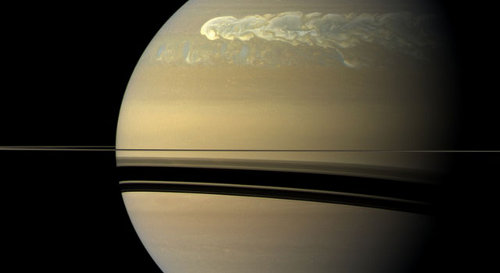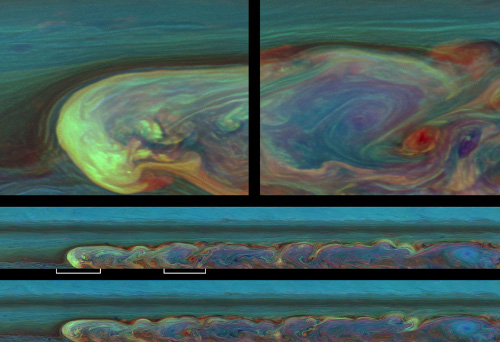I had been intending to cover recent news about Saturn in an upcoming post anyway, but the images below sealed the deal. They’re further wonders from Cassini, pictures of a massive storm in Saturn’s northern hemisphere that encircles the planet. First detected on December 5, 2010, the storm has been on the rampage ever since at about 35 degrees north latitude. It covers approximately 4 billion square kilometers. Cassini’s radio and plasma wave science instrument has been showing a lightning flash rate 10 times that of any other storms the spacecraft has monitored since its arrival in Saturn orbit back in 2004. The flashes were so frequent at one point that Cassini could no longer resolve individual strokes, although the intensity has now eased.
Image: The huge storm churning through the atmosphere in Saturn’s northern hemisphere, seen here in a true-color view from NASA’s Cassini spacecraft. This view looks toward the sunlit side of the rings from just above the ring plane. The image, captured on Feb. 25, 2011, was taken about 12 weeks after the storm began, and the clouds by this time had formed a tail that wrapped around the planet. Some of the clouds moved south and got caught up in a current that flows to the east (to the right) relative to the storm head. This tail, which appears as slightly blue clouds south and west (left) of the storm head, can be seen encountering the storm head in this view. Credit: NASA/JPL-Caltech/SSI.
It’s interesting to realize that the shadow cast by Saturn’s rings has strong effects on the planet’s weather. This storm is 500 times the area of the largest southern hemisphere storms Cassini has seen on its mission, and scientists are suggesting that we are now seeing such powerful storms in the northern hemisphere because of the change of seasons after the planet’s 2009 equinox. At present, Saturn is entering early northern spring, making this a relatively early storm. In previous years, Earth-based astronomers as well as Hubble have observed huge storms called ‘Great White Spots’ in late northern summer, some of which were as large as this one. Unfortunately, we didn’t have Cassini or Voyager on the scene for previous storms of this magnitude.
“This storm is thrilling because it shows how shifting seasons and solar illumination can dramatically stir up the weather on Saturn,” said Georg Fischer, a radio and plasma wave science team member at the Austrian Academy of Sciences in Graz. “We have been observing storms on Saturn for almost seven years, so tracking a storm so different from the others has put us at the edge of our seats.”
We’re looking at a storm that covers an area eight times the surface area of Earth. Since its arrival, Cassini has detected 10 lightning storms on Saturn, found in an area of the southern hemisphere now known as ‘Storm Alley.’ We’re now getting a glimpse of just how lively a Saturnian spring can be as the Sun’s illumination of the hemispheres changes. The storm is generating huge amounts of radio noise from lightning. At issue is the sudden release of such energies, unlike what we see on Jupiter or, for that matter, the Earth, where numerous storms are active at any given moment. In sharp contrast, Saturn seems quiet for years and then erupts into frenzied activity.
Image: False-color images from Cassini showing clouds at different altitudes. Clouds that appear blue here are the highest and are semitransparent, or optically thin. Those that are yellow and white are optically thick clouds at high altitudes. Those shown green are intermediate clouds. Red and brown colors are clouds at low altitude unobscured by high clouds, and the deep blue color is a thin haze with no clouds below. The base of the clouds, where lightning is generated, is probably in the water cloud layer of Saturn’s atmosphere. The storm clouds are likely made out of water ice covered by crystallized ammonia. Taken about 11 hours — or one Saturn day — apart, the two mosaics in the lower half of this image product consist of 84 images each. The mosaic in the middle was taken earlier than the mosaic at the bottom. Both mosaics were captured on Feb. 26, 2011, and each of the two batches of images was taken over about 4.5 hours. Credit: NASA/JPL-Caltech/Space Science Institute.
The storm on Saturn made the cover of Nature this week. The papers involved are Sánchez-Lavega et al., “Deep winds beneath Saturn’s upper clouds from a seasonal long-lived planetary-scale storm,” Nature 475 (7 July 2011), 71-74 (abstract) and Fischer et al., “A giant thunderstorm on Saturn,” Nature 475 (7 July 2011), 75-77 (abstract).




A reader named Del wrote in to ask this question:
The possibility of detecting extrasolar planet signals like these is real and under investigation, particularly as we get new tools like LOFAR and the Square Kilometer Array online. So this news about Saturn doesn’t change anything as much as it draws our attention once again to this possibility.
And Del, for future reference, remember that our comment policy requires a valid email address.
Glorious imagery! I remember reading an outdated text saying that although Saturn had winds, its atmosphere is relatively calm. It seems that whenever we investigate further, greater complexities are revealed.
The late James Hogan wrote a novel or two about a new planet emerging from Saturn and careening around the Solar System. I wonder what he would’ve made of this storm?
Those are really stunning images.. a psychedelic Saturn! GO Cassini!
“…lightning flash rate 10 times that…” Given that the rate is higher and the strength of the lightning bolts are 10,000 times more powerful than on Earth (http://www.newscientist.com/article/dn17789-lightning-storm-on-saturn-is-longest-in-solar-system.html) then could there be a lightning driven ‘cold flow’ nucleosynthesis going on at Saturn? A handy way to create water molecules and explain Saturn’s rings and icey moons?
Side note: Jupiter’s lightning is 10X more powerful than Earth’s compared to Saturn’s 10,000X more powerful!
If Dale Jacobs is right in his side note, I can’t help combining this with knowledge of the greater stability of Saturn’s atmosphere. Because of this stability we should be able to imagine the airborne life for Saturn that Sagan tried to prove as a viable ecology for Jupiter, and speculate that the lightning strength difference is a consequence of Gaia.
Adam, was James Hogan a follower of Velikovsky? Because he said that Venus emerged from Jupiter and flew around the Sol system causing a bunch of Biblical events before settling down in its present solar orbit.
Rob Henry – excellent thought! Let’s get Cassini zooming in on Saturn’s clouds. The floaters may be just big enough to see. And a re-examination of the Voyager Saturn images is in order. No disrespect, Pioneer 11, I know you were there first, but your images just were not sharp enough for this task.
From Saturn’s New Scientist, a speculative journal…
Scientists discount the possibility of other electricity based life forms on our big sister planet Jupiter’s atmosphere, as electrical activity there is a thousand times less. The only other planet with detectable electrical activity is tiny, hot Earth which has 10,000 times less electrical activity. Obviously not an abode for life as we understand it. It has become cleat that we will have to look outwards to exoplanets for life forms.
Ljk, I am emboldened by your uplifting my previous comment out from the outrageous category. I will thus go on to say, that since life thrives in regular environments and helps stabilise them, we should take a particularly close look at and around Saturn’s enigmatic hexagon.
PS. isn’t it strange how after James Christy discovered Charon a re-examination found that its image was clearly present in every high resolution plate of Pluto in the decade prior to it being actually noticed!
Slightly off topic, but definitely planet-related and worthy of attention:
Greg Laughlin’s Systemic site has two very interesting posts on the occurrence of planets and the planet-metallicity relationship;
The first,
http://oklo.org/2011/06/28/the-silicon-effect/
indicates that ‘stars with high silicon abundances relative to iron show increased planet fractions at given metallicity’, but that this correlation does not exist for oxygen.
The second,
http://oklo.org/2011/07/05/the-planet-metallicity-correlation-for-super-earths-and-sub-neptunes/
explores the planet-metallicity correlation for super-Earths and sub-Neptunes in the Kepler data set and comes to the following fascinating conclusions (the first 3 were already known and are confirmed by the recent data analysis), summarizing:
1) Among low-mass stars (< 0.8 solar mass), there’s a lack of giant planets (the giant planet-stellar mass effect);
2) Among approx. solar mass stars (0.8-1.2 solar mass), there’s a strong correlation between giant planet occurrence and metallicity;
3) Among approx. solar mass stars (0.8-1.2 solar mass), that host (only) low-mass planets, there’s no discernible metallicity correlation;
And the new finding:
4) Among low-mass stars (< 0.8 solar mass), there’s a strong correlation between low-mass planet occurrence and metallicity.
Rob Henry, to put my previous comments in context, check out my article on the Gasbags of Jupiter here:
https://centauri-dreams.org/?p=6308